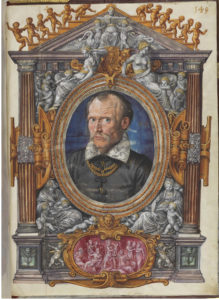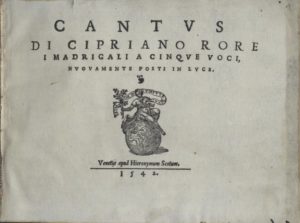Cipriano de Rore, I madrigali a cinque voci (1542)
 Blue Heron, in collaboration with Jessie Ann Owens (Distinguished Professor Emeritus, UC Davis), has undertaken a project to study, perform, and record Cipriano de Rore’s first book of madrigals, I madrigali a cinque voci of 1542. Despite the collection’s seminal importance in the history of the madrigal and the considerable attention it has received in the scholarly literature, primarily on account of its unprecedented organization of a sonnet cycle into polyphonic settings ordered by mode, the set has never been recorded in its entirety and few of the twenty individual madrigals have ever been recorded at all.
Blue Heron, in collaboration with Jessie Ann Owens (Distinguished Professor Emeritus, UC Davis), has undertaken a project to study, perform, and record Cipriano de Rore’s first book of madrigals, I madrigali a cinque voci of 1542. Despite the collection’s seminal importance in the history of the madrigal and the considerable attention it has received in the scholarly literature, primarily on account of its unprecedented organization of a sonnet cycle into polyphonic settings ordered by mode, the set has never been recorded in its entirety and few of the twenty individual madrigals have ever been recorded at all.
The project received initial support from a Noah Greenberg Award conferred by the American Musicological Society in 2015. According to the AMS, “The Noah Greenberg Award was established by the Trustees of the New York Pro Musica Antiqua in memory of their founder and first director. The award is intended as a grant-in-aid to stimulate active cooperation between scholars and performers by recognizing and fostering outstanding contributions to historical performing practices.”
Following an extensive period of preparation and performance, beginning with the creation of a new edition of the music, Blue Heron recorded half of the madrigals in the summer of 2018. The remaining ten will be recorded in June 2019 and the 2-CD set is scheduled for release in September 2019.
The singers for the project are Margot Rood, Martin Near, Owen McIntosh, Jason McStoots, Sumner Thompson, and Paul Guttry. We are working closely with Alessandro Quarta on pronunciation and declamation. Mr. Quarta will also record spoken readings of the poetic texts to accompany the madrigal settings.
Notes on I madrigali a cinque voci by Jessie Ann Owens
[Download a more detailed account here (from the Bulletin of the American Academy of Arts & Sciences, Summer 2018, pp. 25-32).]
 In 1542, a Flemish immigrant to Italy with no steady job that we know of burst onto the musical scene with a remarkable publication. Cuprian De Rore, or Cipriano de Rore, as he signed his name in his letters, was twenty-seven years old, perhaps twenty-eight, and he had not published any of his music when he brought out his I madrigali a cinque voci with a leading Venetian music printer, Girolamo Scotto.
In 1542, a Flemish immigrant to Italy with no steady job that we know of burst onto the musical scene with a remarkable publication. Cuprian De Rore, or Cipriano de Rore, as he signed his name in his letters, was twenty-seven years old, perhaps twenty-eight, and he had not published any of his music when he brought out his I madrigali a cinque voci with a leading Venetian music printer, Girolamo Scotto.
The title page is remarkably spare. We learn nothing about the composer beyond his name—Cipriano Rore. We now think he may have been working as a free-lance composer and living in Brescia, not far from Venice. Just a few years after the publication of this book he would secure the most prestigious post in Italy, chapelmaster for the Duke of Ferrara, so maybe this book functioned like a dissertation or a first academic book, to advertise the composer’s skills to potential employers.
Most madrigal prints at this time were part of a series—first book, second book, etc.—but this title is just I madrigali, the madrigals, as though this would be his only book. The title page includes the conventional “nuovamente posti in luce,” newly published, and as far as we know that is in fact true.
Notice too that the print lacks a privilege, a form of copyright protection granted by the Venetian government, typically printed on the title page. Did Cipriano not understand the value of a privilege for protecting his intellectual property and creative work? Or did he lack the means for filing an application? The book became a best-setter, and four different printers brought out nearly a dozen editions over the course of the century. The blank page on the back of the title page is also noteworthy: there is no dedication, the traditional way of thanking a patron for support. Does this mean that Cipriano paid for the book himself or was there possibly a patron who preferred to lurk unnamed?
Even more remarkable are the contents of this book. This print marked a significant change in the kinds of Italian texts composers were setting, away from lighter and shorter texts, typically set for four voices, to serious texts drawn above all from Petrarch’s Canzoniere, set for five voices. Sixteen of its twenty madrigals are sonnets, and of those sixteen, twelve were by Petrarch. Stylistically, the music made a comparable shift: from the relatively simple chanson-like style of the early madrigal, to a highly-wrought setting that used imitative polyphony of the sort more commonly found in motets. These are long pieces, mostly in two parts (usually with the first eight lines in part one, the last six in part two). It is no exaggeration to say that with this print Cipriano is helping establish the madrigal as a genre that would celebrate the fusion of music and poetry.
But there are other features of this publication that reveal themselves only gradually. Cipriano chose to compose and organize the music in the order of the modes, a kind of predecessor of keys in later music, from mode 1 to mode 8. Only the final three pieces in the book do not adhere to this scheme. The audible effect of this decision allows us to hear the music as two large groupings: the first in the minor modes (similar to dorian or phrygian scales on D or E), and then in the major modes (similar to lydian or mixolydian scales on F and G). This is the first collection to use modal order. And in fact, Cipriano seems to have been among the first composers to understand how to translate the concepts associated with modality, devised originally for monophonic chant, into polyphony. The models he established here would dominate music by composers such as Palestrina and Lassus for the rest of the century.
But there is more. The book opens with a ballata by an unnamed poet who would subsequently be revealed to be the Venetian priest and novelist Giovanni Brevio. This poem functions like a proem or introduction to a previously unrecognized cycle of sixteen sonnets. We will never know for sure, but it seems very likely that Brevio collaborated with De Rore to assemble this set of texts, mostly by Petrarch but also by contemporary imitators of Petrarch, and to organize them in such a way as to create a narrative. This narrative, of loss followed by resignation, matches the affects of the modes. Cipriano’s decision to set the poems in modal order reflects the understanding that particular modes or keys can express the emotions of the texts.
Jessie Ann Owens
Distinguished Emeritus Professor of Music
University of California, Davis
Portrait of Cipriano de Rore by Hans Mielich (1559). Munich, Bavarian State Library, Mus. ms. B, p. 304. Used by permission: Creative Commons Attribution-NonCommercial-ShareAlike 4.0 International (CC BY-NC-SA 4.0).
Title page, Di Cipriano Rore i madrigali a cinque voci (Venice, 1542), Wien, Österreichische Nationalbibliothek, Musiksammlung, SA.77.D.5/1-5 (used by permission).
About Jessie Ann Owens
 Jessie Ann Owens is distinguished professor emeritus of music and former dean of Humanities, Arts and Cultural Studies at the University of California, Davis. She is the author of Composers at Work: The Craft of Musical Composition 1450-1600 (New York, 1997), the first systematic investigation of compositional process in early music, and numerous articles on Renaissance music and music theory. With Katelijne Schiltz she co-edited Cipriano de Rore: New Perspectives on His Life and Music (Turnhout, 2016). She also recently served as guest editor for two issues of the Journal of the Alamire Foundation devoted to Cipriano’s music. A former president of both the American Musicological Society and the Renaissance Society of America, and fellow of the American Academy of Arts and Sciences and honorary member of the American Musicological Society, Owens is currently writing a book about Cipriano de Rore’s dramatic music and co-editing, with John Milsom, Thomas Morley’s A plaine and easie introduction to practical musicke (1597).
Jessie Ann Owens is distinguished professor emeritus of music and former dean of Humanities, Arts and Cultural Studies at the University of California, Davis. She is the author of Composers at Work: The Craft of Musical Composition 1450-1600 (New York, 1997), the first systematic investigation of compositional process in early music, and numerous articles on Renaissance music and music theory. With Katelijne Schiltz she co-edited Cipriano de Rore: New Perspectives on His Life and Music (Turnhout, 2016). She also recently served as guest editor for two issues of the Journal of the Alamire Foundation devoted to Cipriano’s music. A former president of both the American Musicological Society and the Renaissance Society of America, and fellow of the American Academy of Arts and Sciences and honorary member of the American Musicological Society, Owens is currently writing a book about Cipriano de Rore’s dramatic music and co-editing, with John Milsom, Thomas Morley’s A plaine and easie introduction to practical musicke (1597).
About Alessandro Quarta
 A conductor, keyboard player, singer, composer, and linguistic coach, Alessandro Quarta is the founder and director of Concerto Romano, an ensemble dedicated to the rediscovery of Roman and other Italian repertoire of the 16th to 18th centuries that has performed throughout Italy and in Austria, Germany, Belgium, the Netherlands, Switzerland, and the United States, and has released three CDs, including the world premiere recording of Bernardo Pasquini’s Sete di Christo, which was awarded the 2016 Diapason d’or. Quarta is guest conductor of the Orchestra barocca nazionale dei Conservatori italiani, the Kurpfaelzisches Kammerorchester in Mannheim, Germany, the Teatro dell’Opera di Kiel (Germany), and the Teatro Comunale Claudio Abbado in Ferrara, as well as directing baroque opera at the Reate Festival in Rome, and he has played with the Boston Early Music Festival Ensemble and directed the Consortium Carissimi of Minneapolis. He has taught workshops and masterclasses at the Eastman School of Music and at conservatories in Verona, Cologne, Bremen, Milan, and Vicenza. Since 2007 he has been a docent at the International Early Music Course in Urbino presented by the Fondazione Italiana per la Musica Antica (FIMA) and in 2018 was appointed Artistic Director of FIMA’s International Festival of Early Music.
A conductor, keyboard player, singer, composer, and linguistic coach, Alessandro Quarta is the founder and director of Concerto Romano, an ensemble dedicated to the rediscovery of Roman and other Italian repertoire of the 16th to 18th centuries that has performed throughout Italy and in Austria, Germany, Belgium, the Netherlands, Switzerland, and the United States, and has released three CDs, including the world premiere recording of Bernardo Pasquini’s Sete di Christo, which was awarded the 2016 Diapason d’or. Quarta is guest conductor of the Orchestra barocca nazionale dei Conservatori italiani, the Kurpfaelzisches Kammerorchester in Mannheim, Germany, the Teatro dell’Opera di Kiel (Germany), and the Teatro Comunale Claudio Abbado in Ferrara, as well as directing baroque opera at the Reate Festival in Rome, and he has played with the Boston Early Music Festival Ensemble and directed the Consortium Carissimi of Minneapolis. He has taught workshops and masterclasses at the Eastman School of Music and at conservatories in Verona, Cologne, Bremen, Milan, and Vicenza. Since 2007 he has been a docent at the International Early Music Course in Urbino presented by the Fondazione Italiana per la Musica Antica (FIMA) and in 2018 was appointed Artistic Director of FIMA’s International Festival of Early Music.



